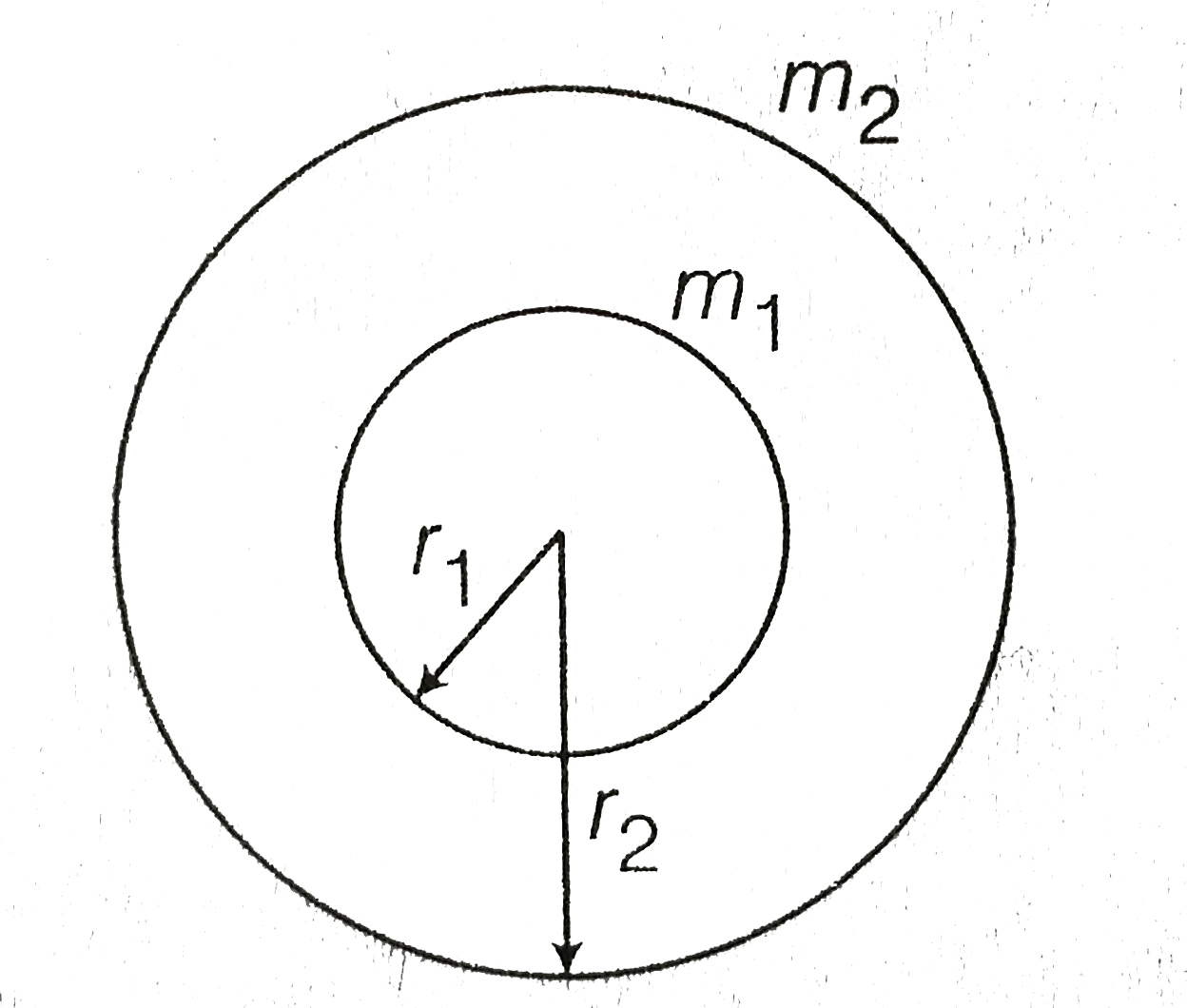Two bodies of masses M1 and M2 are kept separeated by a distance d. The potential at the point where the gravitational field produced by them is zero,the gravitational potential will be :-
−Gd(M1+M2+2√M1M2)
−Gd(M1M2+2√M1+M2)
−Gd(M1−M2+2√M1M2)
−Gd(M1M2−2√M1+M2)
The correct Answer is:A
To solve the problem, we need to find the gravitational potential at a point where the gravitational field produced by two masses M1 and M2 is zero. Here’s a step-by-step solution:
Step 1: Understanding the Setup
We have two masses M1 and M2 separated by a distance d. We need to find a point along the line joining the two masses where the gravitational field is zero.
Step 2: Setting Up the Equation for Gravitational Field
Let’s denote the point where the gravitational field is zero as point O. Let the distance from M1 to point O be x. Consequently, the distance from M2 to point O will be d−x.
The gravitational field E due to a mass M at a distance r is given by:
E=GMr2
Thus, the gravitational fields due to M1 and M2 at point O can be written as:
E1=GM1x2andE2=GM2(d−x)2
Step 3: Setting the Gravitational Fields Equal
For the gravitational field to be zero at point O:
E1=E2
This gives us the equation:
GM1x2=GM2(d−x)2
We can cancel G from both sides:
M1x2=M2(d−x)2
Step 4: Cross-Multiplying
Cross-multiplying gives:
M1(d−x)2=M2x2
Step 5: Expanding and Rearranging
Expanding the left side:
M1(d2−2dx+x2)=M2x2
Rearranging gives:
M1d2−2M1dx+M1x2−M2x2=0
This simplifies to:
M1d2−2M1dx+(M1−M2)x2=0
Step 6: Solving for x
This is a quadratic equation in terms of x. We can use the quadratic formula:
x=−b±√b2−4ac2a
where a=M1−M2, b=−2M1d, and c=M1d2.
Step 7: Finding the Gravitational Potential
The gravitational potential V at point O due to both masses is given by:
V=V1+V2
where:
V1=−GM1xandV2=−GM2d−x
Thus,
V=−GM1x−GM2d−x
Step 8: Substituting x into the Potential Equation
Substituting the value of x obtained from the quadratic solution into the potential equation will yield the final expression for the gravitational potential at point O.
Final Answer
After simplification, the gravitational potential at point O is:
V=−Gd(M1+M2+2√M1M2)
We have two masses M1 and M2 separated by a distance d. We need to find a point along the line joining the two masses where the gravitational field is zero.
Let’s denote the point where the gravitational field is zero as point O. Let the distance from M1 to point O be x. Consequently, the distance from M2 to point O will be d−x.
E=GMr2
Thus, the gravitational fields due to M1 and M2 at point O can be written as:
E1=GM1x2andE2=GM2(d−x)2
For the gravitational field to be zero at point O:
E1=E2
This gives us the equation:
GM1x2=GM2(d−x)2
We can cancel G from both sides:
M1x2=M2(d−x)2
Cross-multiplying gives:
M1(d−x)2=M2x2
Expanding the left side:
M1(d2−2dx+x2)=M2x2
Rearranging gives:
M1d2−2M1dx+M1x2−M2x2=0
This simplifies to:
M1d2−2M1dx+(M1−M2)x2=0
This is a quadratic equation in terms of x. We can use the quadratic formula:
x=−b±√b2−4ac2a
where a=M1−M2, b=−2M1d, and c=M1d2.
The gravitational potential V at point O due to both masses is given by:
V=V1+V2
where:
V1=−GM1xandV2=−GM2d−x
Thus,
V=−GM1x−GM2d−x
Substituting the value of x obtained from the quadratic solution into the potential equation will yield the final expression for the gravitational potential at point O.
After simplification, the gravitational potential at point O is:
V=−Gd(M1+M2+2√M1M2)
Topper's Solved these Questions
- TEST PAPERSBOOK - ALLENCHAPTER - TEST PAPERSEXERCISE - PAPER 2
60 Videos
- TEST PAPERSBOOK - ALLENCHAPTER - TEST PAPERSEXERCISE - PAPER 3
99 Videos
- TEST PAPER 4BOOK - ALLENCHAPTER - TEST PAPER 4EXERCISE - PHYSICS
44 Videos
- UNIT & DIMENSIONS, BASIC MATHS AND VECTOR BOOK - ALLENCHAPTER - UNIT & DIMENSIONS, BASIC MATHS AND VECTOR EXERCISE - Exercise (J-A)
7 Videos
Similar Questions
Two bodies of masses m1 and m2 are placed distant d apart. Show that the position where the gravitational field due to them is zero, the potential is given by, V=−Gd(m1+m2+2√m1m2)
View SolutionIn some region, the gravitational field is zero. The gravitational potential in this region
View SolutionTwo bodies of masses m1 and m2 are placed distant d apart. Show that the position where the gravitational field due to them is zero, the potential is given by, V=−Gd(m1+m2+2√m1m2)
View SolutionTwo unlike charges of magnitude q are separated by a distance 2d. The potential at a point midway between them is
View SolutionFind the potential V at P in the gravitational field of fixed point mass M.
View SolutionTwo particles of masses 'm' and '9m' are separated by a distance 'r'. At a point on the line joining them the gravitational field is zero. The gravitational potential at that point is (G = Universal constant of gravitation)
View SolutionTwo bodies of masses m and 4m are placed at a distance r. The gravitational potential at a point due to mass m on the line joining where gravitational field is zero
View SolutionTwo bodies of masses 10 kg and 100 kg are seperated by a distance of 2 m. The gravitational potential at the mid-point of the line joining the two bodies is:
View SolutionTwo point masses having mass m and 2m are placed at distance d . The point on the line joining point masses , where gravitational field intensity is zero will be at distance
View SolutionAssertion : Two spherical shells have masses m1andm2. Their radii are r1andr2. Let r be the distance of a point from centre. Then gravitational field strength and gravitational potential both are equal to zero for O<r<r1

Reason : In the region r1<r<r2, gravitational field strength due to m2 is zero. But gravitational potential due to m2 is constant (but non-zero).
View Solution
